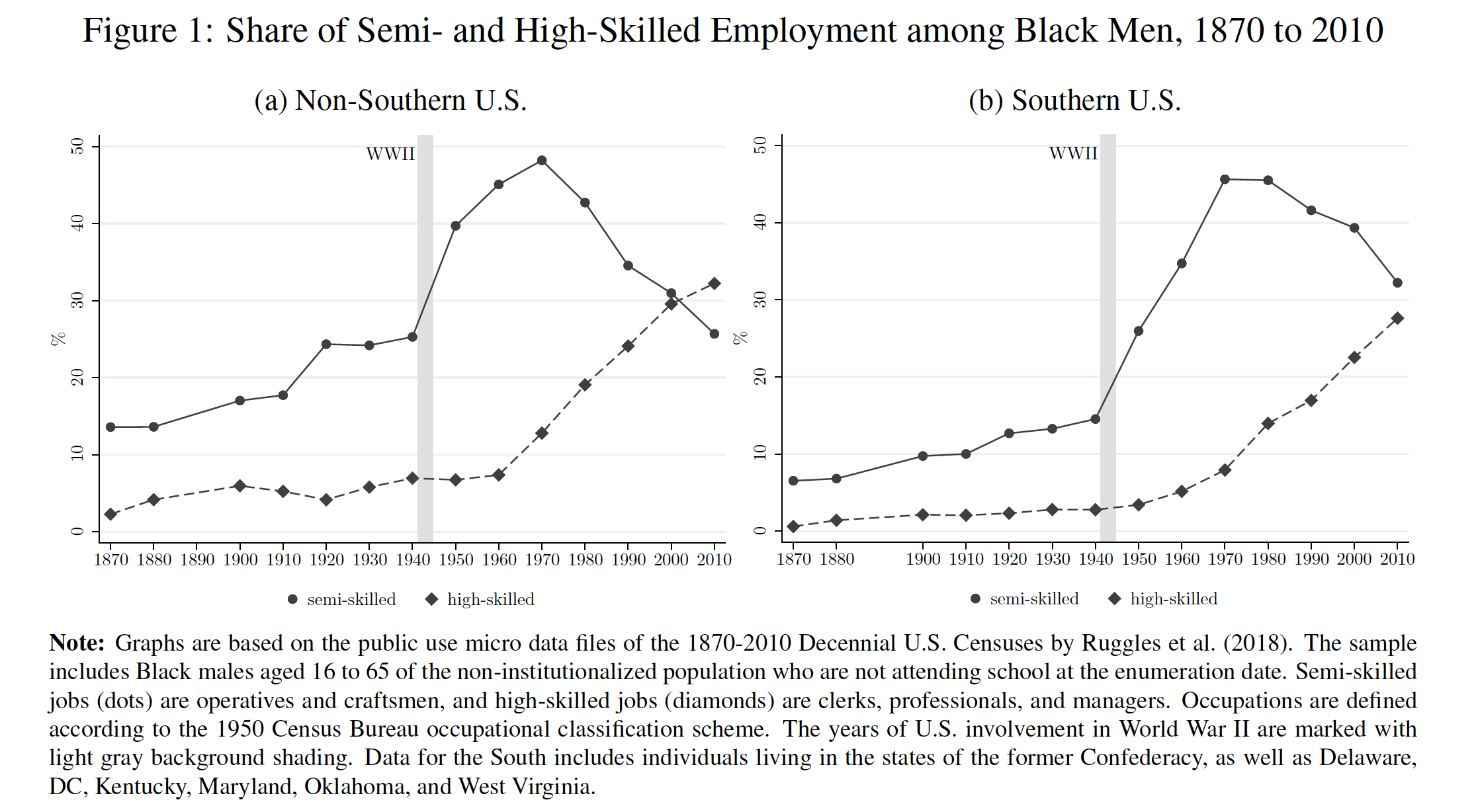Equalising opportunity: the long-term effects of the Second World War on racial diversity in the US labour market

Equalising opportunity: the long-term effects of the Second World War on racial diversity in the US labour market
Monday 24 May 2021Employment inequality has long been a feature of US labour markets. But between 1940 and 1970, Black workers in the South experienced a significant and long-term improvement in their access to semi- and high-skilled jobs. What was behind this change in occupational structure? Andreas Ferrara shows that permanent labour shortages as a result of the Second World War reduced the racial barriers that had previously made such jobs inaccessible to Black workers. His research demonstrates how important equalising opportunity can be for improving the prosperity of minority groups.
Racial disparities in wages and employment opportunities are a feature of US labour markets. Today, the inequalities between Black and white workers are as wide as they were in 1950 (Bayer and Charles, 2018). But these differences have not been constant throughout history. From 1940 to the mid-1970s, the wage difference between Black and white workers began to decline. The period after the Second World War saw tremendous changes for African Americans in the labour market, especially in the Southern states. In 1940, only 15% of Black men worked in semi-skilled jobs, which on average paid twice as much as the low-skilled jobs held by most Black workers back then. In 1970, this share had risen to over 45%. While much work has been done on advancements made by Black workers who left the South during the second Great Migration, the story of Black workers in the South is somewhat less known but equally impressive in terms of the progress made there (see Figure 1). The question is: what contributed to this change in occupational structure?

My research sheds new light on this question by relating this substantial move from low- to semi-skilled jobs among Black Southerners to the Second World War. With 16 million Americans serving in the military, the war created labour shortages that required employers to consider workers whom they would not have ordinarily hired. For instance, Acemoglu et al. (2004) document how states with higher draft rates saw increased female labour force participation. Unlike most Black and white women who found employment during the war years, however, the occupational gains made by Black men remained in place after the war ended and soldiers returned home to their old jobs. To explain the persistence of this occupational upgrading, my analysis focuses on the 420,000 soldiers who did not return from the war and left a permanent gap in their respective firms. Using a difference-in-differences analysis with county-level data from the US Census between 1920 and 1960, I show that Southern counties with higher wartime mortality rates among semi-skilled white soldiers experienced more occupational upgrading for Black Southerners. Other events, such as the effects of New Deal spending in the decade prior to the war, the overall convergence of wages at the time, skill-biased technological change in the agricultural sector, or the migration of Black workers within and out of the South cannot explain away this finding.
On average, each fallen semi-skilled white man was replaced by two to three Black workers. This higher than one-to-one substitution can be explained by a learning-by-doing model used by employers as well as race-based referral networks in hiring decisions (Royster, 2003). Once firms hired their first Black worker, employers updated their racially prejudiced beliefs about the productivity or characteristics of this group. A similar effect was found during the First World War, when firms hired an additional Black worker for each Black worker they had had in 1914, thus doubling their African American workforce (Montgomery, 1991). Given that the war effort during the Second World War was about four times as large as the First World War in terms of mobilised and fallen soldiers, this can explain the larger substitution patterns found in my study. Overall, the average mortality rate among semi-skilled white soldiers can explain a quarter of the overall occupational upgrading from low- to semi-skilled work among Black Southerners between 1940 and 1960.
The war and the permanent labour shortages it created essentially opened employment opportunities for Black Southerners that would not have been available to them otherwise by reducing the racial barriers to entry to such jobs. Even though this was not an intentional design and more a product of a historic event, the example shows how equalising opportunities in the labour market can significantly improve the economic position of a minority group.
Andreas Ferrara, University of Pittsburgh
Further Reading
Acemoglu, Daron, Autor, David H., and Lyle, David (2004). ‘Women, War, and Wages: The Effect of Female Labor Supply on the Wage Structure at Midcentury’. Journal of Political Economy, Vol. 112 (3), 497–551.
Bayer, Patrick and Charles, Kerwin K. (2018). ‘Divergent Paths: A New Perspective on Earnings Differences Between Black and White Men Since 1940’. Quarterly Journal of Economics, Vol. 133 (3), 1459–1501.
Ferrara, Andreas (2020). World War II and Black Economic Progress. CAGE working paper (no. 387).
Montgomery, James D. (1991). Social Networks and Labor-Market Outcomes: Toward an Economic Analysis. American Economic Review, Vol. 81 (5), 1408–1414.
Royster, Dierdre A. (2003). Race and the Invisible Hand: How White Networks Exclude Black Men from Blue-Collar Jobs. University of California Press, Berkeley, CA.
